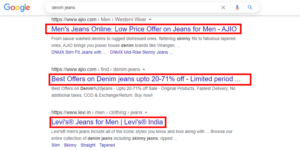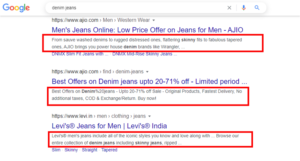SEO - In this digital age, marketing has transformed in ways like never before.
The new era of marketing, that is ‘digital marketing’, has caught up with marketers and businesses across the world. The internet is a strong medium for businesses, both small and large, to reach vast groups of potential consumers and expand their business rapidly. We are here to discuss Search Engine Optimisation (SEO). It has been a key element of digital marketing since its beginning in the late 1990s. SEO is primarily used for increasing a website’s visibility in ‘organic’ search results, i.e., results which are not affected by advertisements.
Let us understand in detail what SEO is and why is it necessary.
SEO and Its Importance
SEO is defined as the process of enhancing the visibility of a website in the unpaid results of a search engine. It is used for increasing the quantity and quality of users and customers who visit a business’s website.
SEO is necessary for every business that is present online, or aspires to create an effective online presence, as it helps in finding your business website on the top result pages of major search engines like Google, Yahoo or Bing.
If you run a business, SEO can actually help you in generating more relevant traffic for your business website, leads, sales, and ultimately revenue and profit. It is an extremely valuable tool for your brand’s marketing as well as building relationships with potential customers by making your brand visible to them consistently on top results.
To understand how SEO actually makes all the above-mentioned things possible, it is important to understand how search engines like Google and Yahoo work.
How Do Search Engines Work?
Search engines work as answering machines to all your queries. They discover, understand, and organize the content and information on the internet to give you the most relevant results for your questions.
Without understanding the working process of search engines, it is impossible to understand the significance and functioning of SEO. Basically, search engines are designed to perform three primary functions, that are-
Crawling: Searching for content and looking through the content for each link that the search engine finds on the Internet. It is a discovery process for content and is called crawling. Content, in whatever format it may be in a webpage, image, video, a PDF, etc. is always discovered through its link.
Indexing: Storing and organising the content collected during crawling. This is called page indexing. After a page indexed, i.e., its content is collected; the page is ready to be displayed as a result of related queries. Indexed pages are a huge database of all the content that search engines discover and deem suitable to show to searchers.
Page Ranking: Providing the relevant content that will best answer a searcher’s query, meaning that the search results are ordered by most relevant to least relevant. This is called page ranking. The higher a website is ranked, the more relevant it is perceived to be by the search engine for the related query.
‘‘
Search engines discover, understand, and organize the content and information on the internet to give you the most relevant results for your questions.
So, for your business website to show up in search results, it has to be visible to search engines. To understand how to make your website visible on search engines, let’s go through what needs to be done for optimizing a website.
To ‘optimise’ a website, that is, for it to show in top search results of a search engine, search engine optimization (SEO) is done. There are three key processes in SEO, which are:
Keyword Research
On-site (On-page) SEO
Off-site (Off-page) SEO
Keyword Research- Finding the key
The purpose behind finding keywords on search engines is that they tell you what people are searching for on the internet that is related to your business or field of interest. This targeted research helps you to tap into a wide pool of internet users that can be turned into potential customers for whatever your business is offering. Keyword research, hence, is a formative and significant part of SEO. It gives you a better understanding of the demand for certain keywords on the internet, and helps you strategise a way to compete for those keywords in search engine results.
How to search for keywords?
Follow this 8-step strategy to do keyword research for your business website’s SEO.
Analyse your topic of interest
Before getting to keywords for optimizing your website, begin by studying and researching the industry of your business and its other necessary details.
Jot down your goals
Answer all the W-questions for your own understanding and strategic planning of SEO using keywords. W-questions will include- who are you, what is your business about, what is your uniqueness, what is your website about, what services will you give on your website, etc.
Focus on search intent
Search intent is the intent or reason why people search for a specific term. People’s search habits are driven by various factors, and you need to analyse these factors for attracting them to your website. Focus on factors like what are they searching for, do they buy the searched product or just browse for it, etc.
List all the topics related to your business
Prepare a list of subsections and sub-topics of the main aspect of your business. This list will comprise all the topics related to your business that will help your website to rank on search engines. Suppose you are selling shoes and footwear items online. The subcategories/topics can include Men’s Shoes, Women’s Shoes, Formal Shoes, etc.
Create a list of seed keywords
Make a list of seed keywords. These are the keywords that are short and typically one or two words long without any modifiers. The seed keywords should be related to the various subcategories and topics that you listed in the previous step. For example, if the seed keywords for your online shoe store can simply be running shoes, sports shoes, Nike shoes, etc.
Search for long-tail keywords
While seed keywords are short terms, long-tail keywords are more descriptive words that are closely related to your business. These long words describe your businesses’ smaller sub-topics. For example, a long keyword can be ‘size 11 men’s Nike running shoes.
Use good keyword research tools
Always use trusted and reliable keyword research tools. Some of the best tools are Google Keyword Planner and Keyword Tool. These tools help you in shortlisting the right words related to your business/ brand while suggesting additional ideas for related keywords.
Keyword Competition Analysis
By doing keyword competition analysis, you can find out how difficult the ranking process will be using a particular keyword. The competition for a keyword can vary depending on how popular the keyword is and industry competition.
On-Page (On-Site) Optimization
On-page SEO, also known as On-site SEO, is the process of optimizing a website for search engines and users. Along with ranking your website higher on search engines, the purpose of on-page SEO is to optimize and update the design, user experience, content and relativity of your businesses’ website with target audiences.
On-page SEO techniques play a major role in making your website resonate with audiences through with the help of elements like meta tags and content activity. SEO practices generally include improving title tags, content, internal links, and URLs for helping rank your website higher.
Why is On-Page SEO Important?
On-page SEO is important because it helps in getting your website and its content recognized by search engines for relevant searches by your potential customers. Search Engine Results Pages (SERPs) play a major role in building the image and presence of your business through websites and web pages in SEO. Search engines like Google understand what users are actually searching for when they type a query and deliver search results that meet the needs of the user.
This all is greatly impacted by SEO. And to ensure that your website is well-optimized according to the latest trends of the SEO and search engine practices, it is necessary to do on-page SEO for text, images, video, or audio content of your website. These are the elements that are visible to the public and play a key role in the SEO process.
‘‘
A website’s appeal, relatability and creditworthiness are attained by linking it to other reputable sources on the Internet from behind the scenes.
How does on-page SEO work?
To understand the functioning of on-page SEO, it’s important to understand the following key elements of it:
Title Tag: The title is placed at the header of each webpage of your website. It provides context as to what the topical subject matter of the respective page is on.

Meta Description: Meta descriptions provide a description of what the page is about, and are often displayed in the SERPs (search engine results pages) underneath the title of the page.

Headlines: A headline is necessary for you to determine if a customer clicks on your website or just sees it. It is necessary to create headlines that interest users and attract them to click through and continue browsing the website.

Header Tags: Header tags are used to identify headings and subheadings within your content from different forms of text.
SEO Writing: SEO writing comprises writing content while keeping both search engines’ and user’s perspective in mind. SEO content has to be refined, apt and relevant.
Content Audit: Auditing helps you evaluate whether your existing content is achieving its goals and gaining ROI. It tells you what you focus should be on while creating relatable and SEO standard content.
Image Optimization: Optimizing images means using high quality HD images to make your website stand out and more attractive.
User Engagement: User engagement means retaining users on your website. To ensure that users do not bounce off your website, your content should interact and resonate with the audiences. To increase user engagement, factors like site speed, user experience, and content optimization, among others, are of key significance.
Off-Page (Off Site) Optimization
Off-page SEO, also known as off-site SEO, consists of actions taken outside of your website to increase the ranking of your website within SERPs. Off-page SEO activities include improving search engine and user interaction of a website.
Why is off-page SEO necessary?
A website’s appeal, relatability and creditworthiness are attained by linking it to other reputable sources on the Internet from behind the scenes; this isn’t visible to the normal users. Linking your website with various credible sources on the internet is that major function of off-page SEO. It expands your business website’s influence by gathering views through links from other sites that are similar to yours.
The relevance, trustworthiness, and authority of a website make it a success. Off-page SEO plays a major role in helping you build a credible website and improves its ability to rank high on SERPs.
How does off-page SEO work?
Creating backlinks, i.e., an incoming hyperlink from one web page to another website is central to off-page SEO. Search engines use backlinks as indications of the linked-to content’s quality. Thus, a website with numerous high-value backlinks ranks better than an otherwise similar site with fewer backlinks.
There are three main types of backlinks that run off-page SEO practices. They are:
Natural links
These links are linked to without any action on the part of a page owner. For example, a food blogger adding a link to a post that points toward their favourite produce farms is a natural link.
Manually Built Links
These are linked to by purposefully link-building activities. For example, the food blogger can add activities on her/his blog, like a website URL, unmoderated blog comments, guest post signatures, advertorials (advertisement + editorial content), embeddable widgets, other user profile pages, etc.
Self-Created Links
These are created by activities such as adding a backlink in an online blog, writing platform, comment signature, etc. with optimized text.
Other than earning links from external websites for off-page SEO, there are other actions too that help your website to get ranked higher. These include:
Social Media Marketing
Using social media platforms like Facebook, Twitter, LinkedIn, Instagram, etc., to market your products and services.
Guest Blogging
It refers to getting your website’s content written by an outside writer.
Linked & Business References
This refers to the online references related to your business that are not linked to your site. They present an opportunity to claim new links.
Influencer Marketing
Influencer marketing involves brands collaborating with online influencers to market products or services.
SEO Best Practices
Best SEO strategy helps you know what’s working and what isn’t. SEO is an ever-adjusting approach. It is an ongoing process as you have to keep adding and updating it along the way in order to stay relevant.
SEO best practices are the safest and most effective SEO activities that help you in substantially increasing the visibility of your website. Following are the best and most effective SEO practices:
Align your content with search intent
Write a compelling title tag and meta description
Optimize your images
Optimize your page speed
Use internal linking
Improve the user experience on your website
Include keywords in your URL
Focus on getting more authoritative backlinks
Publish long-form content
Avoid keywords stuffing
Conclusion
In a nutshell, SEO tools are important in helping you increase the value of your website in accordance with the standards of major search engines. And with improved search traffic, it helps you give a major boost to your business.
Now that you are familiar with SEO, you should move to the next best strategy to leverage your gains by SEO into getting substantial business growth. Use SEM- Search Engine Marketing; it is the practice of marketing a business using paid advertisements that appear on search engine results pages. Read more about it on our website.




